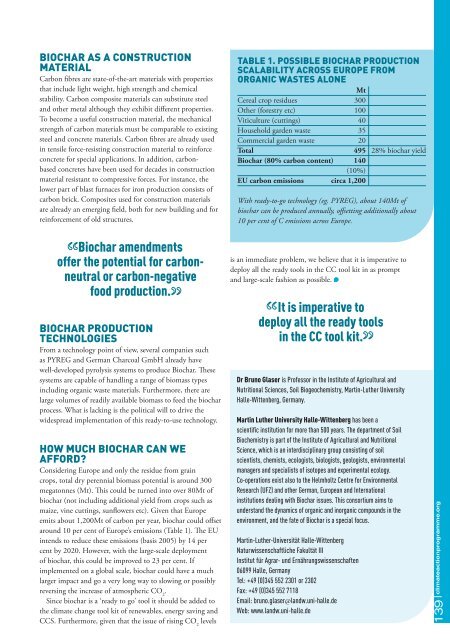Climate Action 2011-2012
Create successful ePaper yourself
Turn your PDF publications into a flip-book with our unique Google optimized e-Paper software.
ioChar as a ConstruCtion<br />
material<br />
Carbon fibres are state-of-the-art materials with properties<br />
that include light weight, high strength and chemical<br />
stability. Carbon composite materials can substitute steel<br />
and other metal although they exhibit different properties.<br />
To become a useful construction material, the mechanical<br />
strength of carbon materials must be comparable to existing<br />
steel and concrete materials. Carbon fibres are already used<br />
in tensile force-resisting construction material to reinforce<br />
concrete for special applications. In addition, carbonbased<br />
concretes have been used for decades in construction<br />
material resistant to compressive forces. For instance, the<br />
lower part of blast furnaces for iron production consists of<br />
carbon brick. Composites used for construction materials<br />
are already an emerging field, both for new building and for<br />
reinforcement of old structures.<br />
table 1. possible bioChar produCtion<br />
sCalability aCross europe from<br />
organiC Wastes alone<br />
Mt<br />
Cereal crop residues 300<br />
Other (forestry etc) 100<br />
Viticulture (cuttings) 40<br />
Household garden waste 35<br />
Commercial garden waste 20<br />
Total<br />
495 28% biochar yield<br />
Biochar (80% carbon content) 140<br />
(10%)<br />
EU carbon emissions circa 1,200<br />
With ready-to-go technology (eg. PYREG), about 140Mt of<br />
biochar can be produced annually, offsetting additionally about<br />
10 per cent of C emissions across Europe.<br />
Biochar amendments<br />
offer the potential for carbonneutral<br />
or carbon-negative<br />
food production.<br />
bioChar produCtion<br />
teChnologies<br />
From a technology point of view, several companies such<br />
as PYREG and German Charcoal GmbH already have<br />
well-developed pyrolysis systems to produce Biochar. These<br />
systems are capable of handling a range of biomass types<br />
including organic waste materials. Furthermore, there are<br />
large volumes of readily available biomass to feed the biochar<br />
process. What is lacking is the political will to drive the<br />
widespread implementation of this ready-to-use technology.<br />
hoW muCh bioChar Can We<br />
afford?<br />
Considering Europe and only the residue from grain<br />
crops, total dry perennial biomass potential is around 300<br />
megatonnes (Mt). This could be turned into over 80Mt of<br />
biochar (not including additional yield from crops such as<br />
maize, vine cuttings, sunflowers etc). Given that Europe<br />
emits about 1,200Mt of carbon per year, biochar could offset<br />
around 10 per cent of Europe’s emissions (Table 1). The EU<br />
intends to reduce these emissions (basis 2005) by 14 per<br />
cent by 2020. However, with the large-scale deployment<br />
of biochar, this could be improved to 23 per cent. If<br />
implemented on a global scale, biochar could have a much<br />
larger impact and go a very long way to slowing or possibly<br />
reversing the increase of atmospheric CO 2<br />
.<br />
Since biochar is a ‘ready to go’ tool it should be added to<br />
the climate change tool kit of renewables, energy saving and<br />
CCS. Furthermore, given that the issue of rising CO 2<br />
levels<br />
is an immediate problem, we believe that it is imperative to<br />
deploy all the ready tools in the CC tool kit in as prompt<br />
and large-scale fashion as possible.<br />
It is imperative to<br />
deploy all the ready tools<br />
in the CC tool kit.<br />
Dr Bruno Glaser is Professor in the Institute of Agricultural and<br />
Nutritional Sciences, Soil Biogeochemistry, Martin-Luther University<br />
Halle-Wittenberg, Germany.<br />
Martin Luther University Halle-Wittenberg has been a<br />
scientific institution for more than 500 years. The department of Soil<br />
Biochemistry is part of the Institute of Agricultural and Nutritional<br />
Science, which is an interdisciplinary group consisting of soil<br />
scientists, chemists, ecologists, biologists, geologists, environmental<br />
managers and specialists of isotopes and experimental ecology.<br />
Co-operations exist also to the Helmholtz Centre for Environmental<br />
Research (UFZ) and other German, European and International<br />
institutions dealing with Biochar issues. This consortium aims to<br />
understand the dynamics of organic and inorganic compounds in the<br />
environment, and the fate of Biochar is a special focus.<br />
Martin-Luther-Universität Halle-Wittenberg<br />
Naturwissenschaftliche Fakultät III<br />
Institut für Agrar- und Ernährungswissenschaften<br />
06099 Halle, Germany<br />
Tel: +49 (0)345 552 2301 or 2302<br />
Fax: +49 (0)345 552 7118<br />
Email: bruno.glaser@landw.uni-halle.de<br />
Web: www.landw.uni-halle.de<br />
139 climateactionprogramme.org












